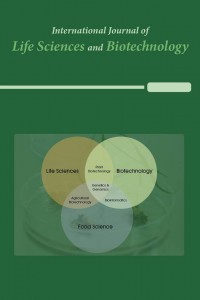Cancer Suppression by Lymphocytes Activated by Cancer-Mediated Exosomes: an In Vitro Study
Cancer Suppression by Lymphocytes Activated by Cancer-Mediated Exosomes: an In Vitro Study
Exosomes immunotherapy, isolation, T lymphocyte,
___
- Zhang, Y., et al., Exosomes: biogenesis, biologic function and clinical potential. Cell Biosci, 2019. 9: p. 19.
- Zhou, X., et al., The function and clinical application of extracellular vesicles in innate immune regulation. Cell Mol Immunol, 2020. 17(4): p. 323-334.
- Barros, F.M., et al., Exosomes and Immune Response in Cancer: Friends or Foes? Front Immunol, 2018. 9: p. 730.
- Utsugi-Kobukai, S., et al., MHC class I-mediated exogenous antigen presentation by exosomes secreted from immature and mature bone marrow derived dendritic cells. Immunol Lett, 2003. 89(2-3): p. 125-31.
- Li, X., et al., Role of exosomes in the immune microenvironment of ovarian cancer. Oncol Lett, 2021. 21(5): p. 377.
- Rialdi, A., et al., The RNA Exosome Syncs IAV-RNAPII Transcription to Promote Viral Ribogenesis and Infectivity. Cell, 2017. 169(4): p. 679-692 e14.
- Majer, O., et al., UNC93B1 recruits syntenin-1 to dampen TLR7 signalling and prevent autoimmunity. Nature, 2019. 575(7782): p. 366-370.
- Wolfers, J., et al., Tumor-derived exosomes are a source of shared tumor rejection antigens for CTL cross-priming. Nat Med, 2001. 7(3): p. 297-303.
- Wu, F., et al., Exosomes increased angiogenesis in papillary thyroid cancer microenvironment. Endocr Relat Cancer, 2019. 26(5): p. 525-538.
- Li, X.B., et al., Role of exosomes in immune regulation. J Cell Mol Med, 2006. 10(2): p. 364-75.
- Borst, J., et al., CD4(+) T cell help in cancer immunology and immunotherapy. Nat Rev Immunol, 2018. 18(10): p. 635-647.
- Wang, Z.X., et al., Combination of chemotherapy and immunotherapy for colon cancer in China: a meta-analysis. World J Gastroenterol, 2014. 20(4): p. 1095-106.
- Taghizadehghalehjoughi, A., A. Hacimuftuoglu, and A. Yilmaz, Na+ channel blocker enhances metformin effects on neuroblastoma cell line. Medicine Science, 2019. 8(3): p. 636-40.
- YILMAZ, A., et al., Investigation of Aloe Vera Barbadensis Miller Leaf Extract Effects On Glutamate and Glyphosate Induced Toxicity: In Vitro Study. Journal of Anatolian Environmental and Animal Sciences, 2021. 6(3): p. 376 - 381.
- Liu, Y., et al., Exosomes and Their Role in Cancer Progression. Front Oncol, 2021. 11: p. 639159.
- Whiteside, T.L., Tumor-Derived Exosomes and Their Role in Cancer Progression. Adv Clin Chem, 2016. 74: p. 103-41.
- Cohen, E.E.W., et al., The Society for Immunotherapy of Cancer consensus statement on immunotherapy for the treatment of squamous cell carcinoma of the head and neck (HNSCC). J Immunother Cancer, 2019. 7(1): p. 184.
- Ganesh, K., et al., Immunotherapy in colorectal cancer: rationale, challenges and potential. Nat Rev Gastroenterol Hepatol, 2019. 16(6): p. 361-375.
- Waldman, A.D., J.M. Fritz, and M.J. Lenardo, A guide to cancer immunotherapy: from T cell basic science to clinical practice. Nat Rev Immunol, 2020. 20(11): p. 651-668.
- Oldford, S.A., et al., Tumor cell expression of HLA-DM associates with a Th1 profile and predicts improved survival in breast carcinoma patients. Int Immunol, 2006. 18(11): p. 1591-602.
- Dieu-Nosjean, M.C., et al., Long-term survival for patients with non-small-cell lung cancer with intratumoral lymphoid structures. J Clin Oncol, 2008. 26(27): p. 4410-7.
- Gonzalez, H., C. Hagerling, and Z. Werb, Roles of the immune system in cancer: from tumor initiation to metastatic progression. Genes Dev, 2018. 32(19-20): p. 1267-1284.
- Raskov, H., et al., Cytotoxic CD8(+) T cells in cancer and cancer immunotherapy. Br J Cancer, 2021. 124(2): p. 359-367.
- Ross, S.H. and D.A. Cantrell, Signaling and Function of Interleukin-2 in T Lymphocytes. Annu Rev Immunol, 2018. 36: p. 411-433.
- Reem, G.H. and N.H. Yeh, Interleukin 2 regulates expression of its receptor and synthesis of gamma interferon by human T lymphocytes. Science, 1984. 225(4660): p. 429-30.
- Kasahara, T., et al., Interleukin 2-mediated immune interferon (IFN-gamma) production by human T cells and T cell subsets. J Immunol, 1983. 130(4): p. 1784-9.
- Yayın Aralığı: Yılda 3 Sayı
- Başlangıç: 2018
- Yayıncı: International Society of Academicians
Çeşitli evsel atıkların Aureobasidium pullulans tarafından melanin sentezinde kullanılması
Sk Injamamul ISLAM, Moslema Jahan MOU, Saloa SANJİDA, Md. SAROWER-E-MAHFUJ, Md. Ashraful ALAM, Yeasmin ARA
Özlem BAKIR, Esabi Başaran KURBANOĞLU
Plant Attractants and Rewards for Pollinators: Their Significant to Successful Crop Pollination
Nur Athirah ZARİMAN, Nurul Alia OMAR, A. NURUL HUDA
Assessment of Food Safety During Covid-19 Pandemic
Cennet Pelin BOYACİ GUNDUZ, Mehmet Fatih CENGİZ
Cancer Suppression by Lymphocytes Activated by Cancer-Mediated Exosomes: an In Vitro Study
Aysegul YILMAZ, Irmak FERAH OKKAY, Ali TAGHİZADEHGHALEHJOUGHİ
Melisa BEYHAN YILMAZ, Fahriye ZEMHERİ NAVRUZ, Ecem SEÇGİNLİ
Hatice Aysun MERCİMEK TAKCI, Sema GENÇ, Ayşenur YALÇIN, Eda ÖZDEMİR
Firdausi ALİYU, Aliyu ADAMU, Roswanira AB. WAHAB, Fahrul ZAMAN HUYOP
